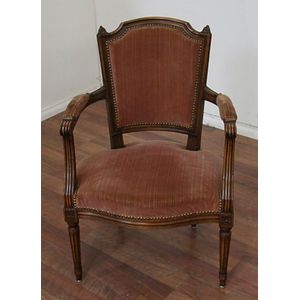French Mahogany Fauteuils with Green Velvet Upholstery
You must be a subscriber, and be logged in to view price and dealer details.
Subscribe Now to view actual auction price for this item
When you subscribe, you have the option of setting the currency in which to display prices to $Au, $US, $NZ or Stg.
- Reeding - A series of parallel, raised convex mouldings or bands, in section resembling a series of the letter 'm'. The opposite form of fluting, with which it is sometimes combined. Reeding is commonly found on chair legs, either turned or straight, on the arms and backs of chairs and couches and around table edges in the Neoclassical or Classical Revival manner. Reeding was also used as a form of decoration during the Edwardian period, but it is usually much shallower and evidently machine made.
- Pierced Decoration - Ornamental woodwork with part of the background cut through and removed to produce an open-work pattern.
- Cresting - The decorative carving at the top of a piece of furniture, such as a sideboard back, a mirror, or a chair back.
- Restauration Period - The Restauration period in French history refers to the years from 1815 to 1830. It followed the fall of Napoleon Bonaparte and the end of the Napoleonic Wars. During the Restauration, the Bourbon monarchy was restored to power in France with Louis XVIII as king. This period was characterized by a conservative and reactionary political climate, as the monarchists sought to undo the liberal and republican ideals of the French Revolution. The Restauration also saw the rise of industrialization and the growth of a middle class in France.
- Rail - A term used by cabinet makers for the horizontal sections of the frame of an item such as a chair or settee which have a front rail, a back rail and two side rails, and also on a door or carcase, where the rails are joined to the vertical framings.
- Mahogany - Mahogany is a dense, close grained red-coloured timber from the West Indies and Central America. It was first imported into Europe in the the early 18th century and its use continued through the 19th century. It was popular for furniture making because of its strength, the wide boards available, the distinctive grain on some boards, termed flame mahogany and the rich warm colour of the timber when it was polished.. The "flame" was produced where a limb grew out from the trunk of the tree, and this timber was usually sliced into veneers for feature panels on doors, backs and cornices.
Some terms used to describe mahogany relate to the country from which it originally came, such as "Cuban" mahogany, "Honduras" mahogany etc. However unless the wood has been tested the names assigned are more a selling feature, rather than a true indication of the timber's origin. - Baluster (furniture) - An architectural term for a column in a balustrade or staircase, often defined as a "vase shape". The shape is extensively used in furniture and decorative arts.
In furniture, it is used to describe a chair or table leg turned in that form, or more usually as an inverted baluster, with the bulbous section to the top. Less commonly used to describe a chair back that has the outline of a baluster. A baluster may also be split and applied to the front of a cupboard for ornamentation.
For ceramics and silver items it is often used to describe the shape of the whole item, rather than a part.
In Georgian glassware, the shape is commonly seen in the stem of glasses.
This item has been included into following indexes:
-
chairs, singles / pairs / threes, style or period
- fauteuils (arm chairs) 240
- French 949
- chairs, singles / pairs / threes, timber - mahogany 1,098
Visually similar items

A French Louis XVI style walnut fauteuil.

An 19th century rosewood campaign chair

A set of ten good mid-Victorian mahogany dining chairs, 1860s, each with a moulded balloon back with a foliate-carved interlaced centre above the stuff-over seat covered in close-nailed brown leather, on tapering turned front legs (one chair later, made to

Cedar armchair, Australian c. 1826, the curved top rail above a plain curved cross rail, down swept arms on turned supports and raised on turned tapering legs, stamped on rear of back leg ALENEHAN. Height 87 cm
